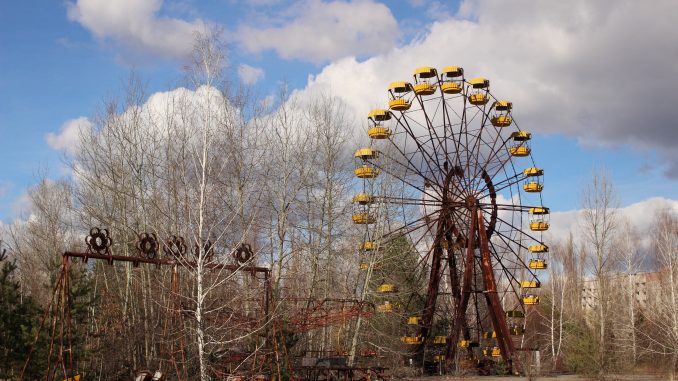
I awoke in Kyiv, Ukraine, with strange adrenaline pumping through my veins.
A tour guide would soon pick up my friend Chris and me from our hotel to take us to Chernobyl, the town where a major nuclear explosion occurred in 1986.
I work part time as an account coordinator for a company that supplies police security equipment through United States embassies abroad, and this was my spring break.
I’d spent half the night online, trying to determine if visiting Chernobyl was indeed safe. Ukraine allows visits up to five days, but scientists say Chernobyl won’t be habitable due to the lasting effects of radiation for 20,000 years. Part of me wondered why I was spending $150 to willingly walk into the aftermath of a nuclear catastrophe.
The explosion of Chernobyl’s nuclear power plant, Reactor 4, is one of the worst nuclear accidents in history. The explosion resulted from a combination of mechanical and human error, and the radioactive particles released into the air caused severe cancers, genetic mutations and birth defects across eastern Europe for generations.
The accident also resulted in the mass relocation of Ukrainian citizens and significant damage to the environment.
Now, Chernobyl is completely abandoned. And Wednesday will mark 31 years from the explosion.
“Is this really safe?” I nervously asked our tour guide, Igor, who arrived promptly at 8 a.m.
“I’ve been hundreds of times,” Igor said. “And the lunches are prepared outside of Chernobyl, or so they say.”
Soon we reached a security checkpoint in the exclusion zone, a 30-kilometer uninhabitable buffer area around Reactor 4 meant to prevent radioactivity from spreading. We signed liability paperwork as our passports were inspected. The guards instructed us to not touch walls or vegetation, as they harbored the highest levels of radiation.
I realized I was really there, and my anxiety worsened. But there was no turning back now.
Clearing security, we drove through the deserted region, parking the car in spots along the way to walk around. The roads were smooth — most of the pavement had been replaced to reduce radiation levels. The surrounding woodlands used to be called the Red Forest for their colorful foliage, but now the trees are barren.
While exploring, we used a Geiger counter, a tool that detects radiation, to alert us of jumps in levels.
Entering the buildings is technically prohibited, but I quickly learned the tour guides like to break rules to impress guests.
Igor first led us through some abandoned homes. We balanced on rotting, exposed floorboards. Random shoes, kitchen apparatus and wall décor were strewn about, signs of a life once lived.
Next, we explored a daycare center. Rooms were filled with rickety bunk beds, creepy dolls and children’s toys. Outside, Igor showed us how the Geiger counter jumped near dirt or moss.
We continued to Reactor 4, now in a concrete casing to prevent further contamination. It’s still functional, and I watched workers nonchalantly walk inside.
We took a break for lunch. Chris and I were too nervous to eat the soup or vegetables provided. We stuck to bread and bottled water.
“I’m never going to make another joke again,” Igor said.
In Pripyat, a neighboring town also affected by the nuclear explosion, we saw an abandoned amusement park that operated for only one day. According to Igor, it opened early that day to distract residents from the explosion.
We continued to a nearby community pool, which Igor said was used for 10 years after the accident. The decaying diving board and basketball hoop were eerie — people once came here for fun.
Igor led us through abandoned apartments and schools. Soviet propaganda hung on the walls and chemistry sets and textbooks lay forgotten in the classrooms. One classroom was filled with gas masks.
Most of the time, I felt like I was in a scene right out of a horror movie.
Before leaving in the evening, we had to undergo a full-body radiation check. I stepped into the machine, petrified I’d be contaminated and left behind. Thankfully, I was cleared.
Though Chernobyl was one of the most interesting places I’ve seen, it weighed heavily on my mind that it was never meant to be a tourist attraction. It felt strange to be a tourist there, taking photos of the remnants of people’s lives affected by a deadly biological disaster.
I left Chernobyl feeling reminded of life’s unpredictability — unforeseen accidents can happen anytime, and we are helpless to the consequences.
Laura Smythe can be reached at laura.smythe@temple.edu.


Be the first to comment